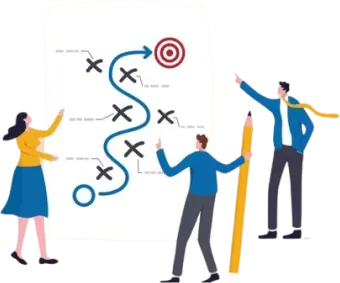22 Aug, 2023 | mobile app development
Flutter Framework : Beautiful Native Apps in Record Time

What is Flutter?
"What is Flutter?" Is a question often asked by newcomers in the field of app development. Flutter, initiated by Google, is a freely accessible toolkit for crafting user interfaces in software development. It is primarily known for facilitating the rapid development of natively compiled applications for mobile, web, and desktop from a single codebase.The Beauty of the Flutter Framework
The Flutter framework is a modern solution that addresses many challenges faced by developers. Here's what makes Flutter stand out:1. Rapid Development
Flutter offers hot reload, which allows developers to instantly see the result of the latest changes. This means testing and iterations are quicker, reducing the overall development time.2. Native Performance
Flutter apps run using the Dart platform, ensuring optimal performance on both iOS and Android.3. Versatile UI
With Flutter, there's an extensive catalogue of widgets that can adapt to any platform, ensuring consistent behaviour and appearance.4. Single Codebase
You can write your app's code once and run it everywhere - be it iOS, Android, web, or desktop.Flutter Programming: Dive into Dart
Flutter isn’t just about a framework; it’s also about a unique flutter programming language – Dart. Flutter and Dart are two peas in a pod, with Dart acting as the backbone for the Flutter framework. Dart Flutter development enables smooth animations and transitions that run at 60fps. For individuals unacquainted with it, Dart is a language optimized for clients, enabling rapid application performance across diverse platforms.Flutter Application Development Process
The flutter application development process is pretty straightforward:- Set Up: Download the Flutter software and set up the Flutter SDK.
- Design the UI: Using the extensive library of widgets and tools, design your app’s interface.
- Write the Code: Use the Flutter programming language, Dart, to bring functionality to your design.
- Test: Run your app on emulators or real devices, and make use of Flutter's hot reload feature for quick iterations.
- Deploy: Once satisfied, deploy your Flutter mobile app to your desired platform.
Becoming a Flutter Developer
So, what is a Flutter developer? A Flutter developer is someone skilled in using the Flutter framework and Dart language to create dynamic, high-performance applications. These professionals understand the intricacies of the framework, from UI design to backend integration.The Widespread Adoption of Flutter
With technology giants like Google backing Google Flutter, its credibility and efficiency are unquestionable. Numerous companies, both large and small, have adopted Flutter development due to its efficiency, performance, and ease of use.Advancing with Flutter: Beyond Basics
While the aforementioned details provide a solid foundation on what Flutter offers, delving deeper paints a richer, more comprehensive picture. Let's dive into the advanced facets of Flutter and why it's becoming the go-to solution for many developers and businesses.Flutter’s Underlying Philosophy
At its core, Flutter is all about delivering a seamless experience. It's constructed around the principle of ‘widgets’ - the fundamental building blocks of its UI. Every aspect, be it a button or a screen, is a widget. This modular approach to design makes Flutter app development highly customizable and scalable. Also Read: Which Mobile App Development Framework Is Right For You?The Ecosystem of Flutter
1. Rich Libraries and Plugins
Flutter boasts a rich ecosystem comprising numerous libraries and plugins that cater to a multitude of functionalities, ranging from accessing hardware-specific services to integrating third-party solutions. This extensive availability streamlines the development process, making it more efficient and less time-consuming.2. Active and Growing Community
Given that Flutter is open-source, it has garnered a vibrant community. This group contributes significantly to its ecosystem, offering plugins, tools, and solutions. The collective effort ensures that developers have ample resources at their disposal.3. Flutter for All: Inclusivity in Design
The Flutter framework also champions inclusivity. Developers can create apps that are accessible to everyone, including users with disabilities. With features ensuring dynamic font sizing, screen readers, and more, apps crafted using Flutter cater to a broader audience.
Continuous Evolution with Flutter
1. Regular Updates
Flutter's team regularly rolls out updates, enhancing its capabilities, optimizing performance, and introducing newer functionalities. This commitment to evolution ensures that the framework remains at the forefront of technology.2. Flutter Engage and Announcements
Events like "Flutter Engage" provide insights into the framework's future and the direction it's headed. Such platforms allow developers to anticipate and adapt to the upcoming trends in Flutter mobile app development.The Global Influence of Flutter
Flutter isn't restricted to any particular geographical location. With its myriad of advantages, businesses and developers from across the globe are adopting it. From startups in Europe to tech giants in Silicon Valley, the footprint of Flutter is expanding rapidly.In Conclusion
As technology keeps evolving, the tools and frameworks that stand out are the ones that adapt, evolve, and consistently meet the users' demands. Flutter, with its promise of efficiency, flexibility, and the power of Dart, is well on its way to redefine app development norms. For anyone contemplating venturing into the world of apps, Flutter offers a universe of possibilities waiting to be explored.Frequently Asked Questions
Developers can benefit from Flutter's features such as rapid development through hot reload, optimal native performance, a versatile UI with a wide range of widgets, and the ability to maintain a single codebase for multiple platforms.
Dart serves as a platform-agnostic programming language tailored for optimal client performance in swift application development. Flutter uses Dart as its primary programming language, leveraging its capabilities to provide smooth animations and transitions at 60fps.
The Flutter app development process involves:
- Setting up the Flutter SDK.
- Designing the user interface using widgets and tools.
- Writing the code using Dart.
- Testing the app on emulators or tangible devices.
- Deploying the app to the desired platform.
A Flutter developer is an individual skilled in using both the Flutter framework and the Dart language. They can create dynamic and high-performing apps, understanding the framework's intricacies, from UI design to backend integration.
With support from a tech giant like Google, Flutter's credibility and efficiency are underscored. This backing ensures consistent updates, technological advancements, and a robust ecosystem for the framework.
Widgets are the fundamental building blocks of Flutter's UI. Everything in Flutter, from a button to an entire screen, is a widget. This modular design approach makes the framework highly customizable and scalable.
Flutter emphasizes creating apps that are accessible to everyone, including users with disabilities. It offers features for dynamic font sizing, screen readers, and more to cater to a wide range of users.
Flutter regularly receives updates to enhance its functionalities, optimize performance, and introduce new features. Events like "Flutter Engage" provide further insights into its future developments.
Yes, Flutter caters to both newcomers and seasoned developers. With its extensive documentation, active community, and intuitive design philosophy, it's a versatile tool for anyone interested in app development.

